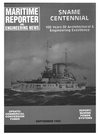
Page 83: of Maritime Reporter Magazine (September 1993)
Read this page in Pdf, Flash or Html5 edition of September 1993 Maritime Reporter Magazine
Navy Reveals Urgent
Need Of Architects,
Marine Engineers (Dateline 1942) The United States
Civil Service Commission has an- nounced that naval architects, marine engineers and electrical marine engineers are urgently needed by the Government for the shipbuilding program in New
York City. The salaries will range from $2,600 to $3,200 per annum.
There is a special need of ma- rine engineers with a knowledge of machine piping, and naval ar- chitects experienced in hull pip- ing and shipfitting. Appoint- ments will also be made of per- sons familiar with ship calcula- tions, structural design, general and machine arrangements.
Applicants must have completed a full four-year course leading to a bachelor's degree in engineer- ing or naval archictecture in a college or university of recognized standing, and, in addition, have had two years of professsional experience, including at least one year of marine experience. Non- college graduates may substitute, year for year, for the education prescribed, engineering or naval architectural experience of defi- nitely professional grade.
Persons interested should ap- ply in person at Room 214, Fed- eral Building, 641 Washington
St., New York City, as soon as possible.
Another instance of the advantages gained by conversion from steam to Diesel in towboat operation has been proven by Terry Buchanan, of the Bronx River Towing Lines, who has just ehaiked up the second profitable year of Marine
Diesel Service. Although a wealth of evidence has been presented, showing the departure of steam power from the field of economical and efficient towboat service, one would have to go far to eclipse the record achieved by the "Buch- anan Sisters" of the Bronx River Towing Line.
This tug of wooden construction with a 73' length, a beam of 20' and a loaded draft of 9'8" was built by her owners at their yards on the
Harlem River in 1923, for 17 years was steam powered and on May 27, 1940 was converted to Marine Diesel power with a Fairbanks-Morse 450 H.P. marine Diesel engine. This staunch tug boasts of a remarkable lack of vibration and outstanding savings in operating costs, running over $14,500,000 a year have been realized.
In addition Mr. Buchanan estimates she has been able to handle additional work amounting to approximately $2500 a month or $30,000 a year. Since the conversion to her Fairbanks-
Morse engine she has never had to tie up for engine trouble, there has never been a break down and the maintenance expense has been less than 4V> cents per horsepower per year.
DIESEL POWER
PROVES PROFITABLE
Ueft to right foreground: John W. Stewart, Captain R. A. Smyth, U.S.C.6., George W. Gibbs, William S. Newell, David Arnatt, Joseph W. Powell, John W. Hendry, H. Gerrish
Smith, In the background left to right: John Heaney, Rear Admiral C. D. Wheelock, Captain R. K. James.
SNAME DELEGATES SAIL FOR EUROPE
Thirty members of The Society of Naval Architects and Marine Engineers attended the International
Conference of Naval Architects and Marine Engineers, which was held in England and Scotland from June 25 to July 6, 1951. Most of the group made the journey on the America.
John Ericsson, a Swedish- born marine engineer, arrived in New York in 1839 to promote the screw propeller as a means of ship propulsion, superior to the paddles in use. He designed and supervised the construction of the famed
Civil War ironclad Monitor. Built in 1896, the armored cruiser "Brooklyn" was the flagship in the battle of Santiago in 1898. The 400-foot vessel was capable of 21-knot speeds.
SNAME Centennial 82C

 82
82

 84
84
